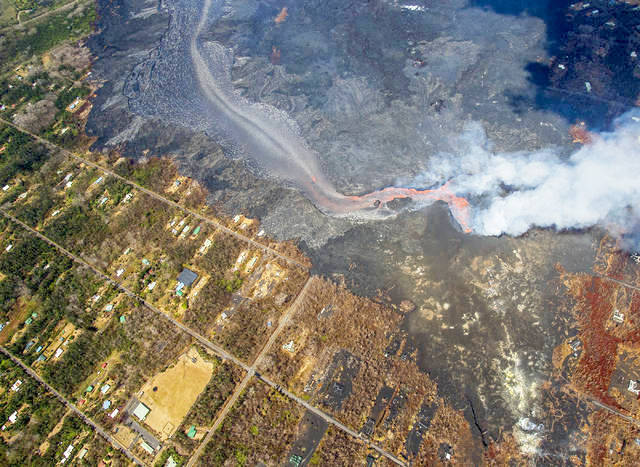HILO — Voluntary housing buyouts will be a priority for a portion of federal funding the county is set to receive for recovery efforts related to the 2018 eruption of Kilauea volcano in lower Puna.
The funding for the proposed effort will come from $83.84 million in Community Development Block Grant Disaster Recovery funds the county will get from the U.S. Department of Housing and Urban Development.
“So we have started to lift up certain projects we think would be a good fit in terms of eligibility and funding opportunity with HUD,” Disaster Recovery Officer Douglas Le said in an update to the County Council Committee on Governmental Relations and Economic Development, where he covered a breadth of recovery-related topics. “One is a voluntary housing buyout program. … We have to work through the program design and also eligibility criteria as part of the standing up of the project, and HUD is advising us on past experience, both lessons learned and best practices from other jurisdictions that have also set up buyout programs.”
In a buyout, a local jurisdiction, in this case the county, would buy property from individual property owners in the impacted areas. The property would not developed after the purchase, Le said in an interview following his committee update.
“For buyout, the policy goal is to kind of get folks out of harm’s way, whether it be a flood, a wildfire risk or, in this case, a volcanic risk, and so it would be kind of open space moving forward,” he said. “We wouldn’t resell it. We wouldn’t allow future development on that parcel.”
Le said the county would prioritize primary residences.
Many who have been displaced might still have a mortgage or financial commitment to that land, while also paying rent or another mortgage where they live now, he said.
The buyout program is one way to help resolve that issue and give individuals the means to leave the area affected by the eruption, said Le.
“But it is a voluntary program, and so I think we’re also trying to be mindful of what it means for folks to choose to stay. … People are going to make decisions on their own, and we’re going to support those decisions. We’re going to invest the money we have to facilitate that.”
According to Le, voluntary buyout programs are an established practice in other disaster areas looking to recover.
“We haven’t gone down to the individual budgeting of the total grant amount, but I think all common sense points to that a good amount of the grant will have to go to buyouts.”
Le said the basis of the buyout value would be pre-disaster market value.
“It’s complicated, in terms of how buyout programs work with federal dollars,” he told the committee, adding that duplication of benefits have to be considered.
That means the buyout value isn’t just the pre-disaster cost for the home; it would have to be adjusted for things like insurance payouts and individual FEMA assistance.
“All these procedures will be kind of mapped out in the design of the program,” said Le. “I think we’re also looking at what housing assistance looks like for folks who were renters and displaced by the event. How can our recovery efforts help to build a pipeline … of affordable housing in the directly impacted areas that helps address our islandwide needs, but also really helps get folks rehoused and secure in (a) financially sustainable way.”
Le said the county is waiting for the publication of HUD’s federal register notice, “which would not only kick-start our process of 120 days, or four months, to develop an action plan, but also to make really crystal clear the rules and regulations and waivers … .”
Public engagement will also be part of that four-month process, Le said.
The county also is continuing its work with the Federal Emergency Management Agency and Hawaii Emergency Management Agency to seek Section 428 funding.
Normally, FEMA wants infrastructure repaired to the state it was before a disaster. FEMA’s Section 428 funding, however, allows for alternative projects and more flexibility.
Le told the committee that final cost estimates for damaged or lost infrastructure would be a capped amount the county can use to “rebuild infrastructure or for alternative projects that aid in the recovery.”
“Where we are now, we are close to kind of locking in the grant amount with FEMA,” Le said. “Nothing is set in stone because I think, for example on the roads, there’s still a lot of back and fort around FEMA understanding our cost estimates relative to the price of doing business here in Hawaii. … But these issues are being worked through. I think even the past couple business days, more information has gone back and forth.
“Long story short, we are still finalizing the cost estimates. I think the roads are the ones that are moving the most, but we’re confident that county department leadership and HI-EMA and FEMA can be able to close this out so we can start moving towards grant agreements, which helps us to get into determining which projects to start off.”
Email Stephanie Salmons at ssalmons@hawaiitribune-herald.com.



